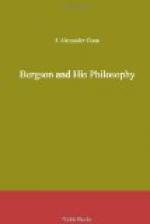through the medium of a developed organism, “an
internal push that has carried life by more and more
complex forms, to higher and higher destinies.”
It is a dynamic continuity, a continuity of qualitative
progress, a duration which leaves its bite on things.
[Footnote: For these descriptions of life, see
Creative Evolution, pp. 27-29 and 93-94 (Fr. pp. 28-30
and 95-96).] We shall be absolutely wrong, however,
if we attempt to view the evolutionary process as
progressive in a straight line. The facts contradict
such a facile and shallow view. Some of the stock
phrases of the earlier writers on Evolution were:
“adaptation to environment,” “selection”
and “variation,” and a grave problem was
presented by this last. How are we to account
for the variations of living beings, together with
the persistence of their type? Herein lies the
problem of the origin of species. Three different
solutions have been put forward. There is the
“Neo-Darwinian” view which attributes variation
to the differences inherent in the germ borne by the
individual, and not to the experience or behaviour
of the individual in the course of his existence.
Then there is the theory known as “Orthogenesis”
which maintains that there is a continual changing
in a definite direction from generation to generation.
Thirdly, there is the “Neo-Lamarckian”
theory which attributes the cause of variation to
the conscious effort of the individual, an effort
passed on to descendants. [Footnote: Concerning
Lamarck (1744-1829) Bergson remarks in La Philosophie
(1915) that without diminishing Darwin’s merit
Lamarck is to be regarded as the founder of evolutionary
biology.] Now each one of these theories explains
a certain group of facts, of a limited kind, but two
difficulties confront them. We find that on quite
distinct and widely separated lines of Evolution,
exactly similar organs have been developed. Bergson
points out to us, in this connexion, the Pecten genus
of molluscs, which have an eye identical in structure
with that of the eye of vertebrates. [Footnote:
The common edible scallop (Pecten maximus) has several
eyes of brilliant blue and of very complex structure.]
It is obvious, however, that the eye of this mollusc
and the eye of the vertebrate must have developed
quite independently, ages after each had been separated
from the parent stock. Again, we find that in
all organic evolution, infinite complexity of structure
accompanies the utmost simplicity of function.
The variation of an organ so highly complex as the
eye must involve the simultaneous occurrence of an
infinite number of variations all co-ordinated to the
simple end of vision. Such facts as these are
incapable of explanation by reference to any or all
of the three theories of adaptation and variation mentioned.
Indeed they seem capable of explanation only by reference
to a single original impetus retaining its direction
in courses far removed from the common origin.
“That adaptation to environment is the necessary
condition of Evolution we do not question for a moment.
It is quite evident that a species would disappear,
should it fail to bend to the conditions of existence
which are imposed on it. But it is one thing to
recognize that outer circumstances are forces Evolution
must reckon with, another to claim that they are the
directing causes of Evolution.” [Footnote:
Creative Evolution, p. 107 (Fr. p. 111).]




